Rowan: Trees, Berries, Flowers. Leaves, Bark – Pictures and Identification Guide

The rowan tree is a small ornamental flowering tree with an attractive crown consisting of pinnately compound leaves. Rowan trees are known for their showy clusters of white spring flowers followed by colorful orange or red berries appearing in the fall. Cold-hardy deciduous rowan trees are found throughout North America and Europe.
Rowan trees like the American rowan tree (Sorbus americana) and the European rowan tree (Sorbus aucuparia) are incredibly easy to grow in temperate climates. The elegant understory trees have plenty of ornamental value to add visual appeal to a garden landscape in spring, summer, fall, and winter. In addition, they are incredibly cold-hardy and tolerate the harshest freezing conditions.
This article is a guide to identifying common types of rowan trees in a landscape. Descriptions and pictures of rowan berries, flowers, leaves, and bark will help you recognize this attractive tree.
What is Rowan Tree (Sorbus)?
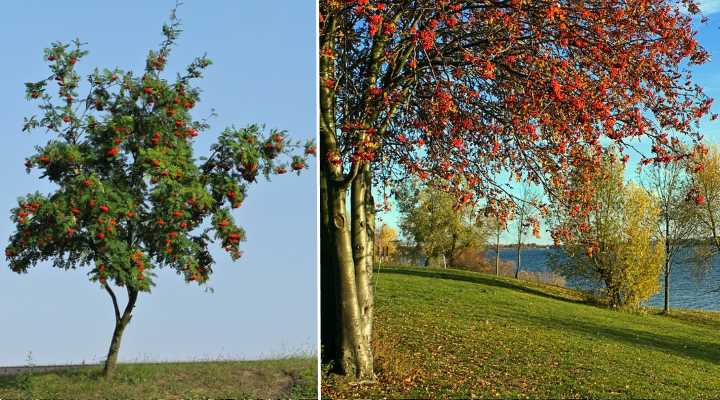
Rowan trees are deciduous, cold hardy and relatively small and are also called mountain ash
The rowan tree is a relatively small deciduous tree in the rose family Rosaceae and genus Sorbus. The most common species of rowan is the American rowan tree which is native to eastern North America. The sun-loving tree, with its dense, dark-green foliage, colorful flowers, and berries, grows easily in acidic soils.
The American rowan tree (Sorbus americana) is more commonly known as the American mountain-ash. It’s an ornamental tree that grows in mountains, forests, rock outcrops, and the lowlands. The common name—mountain ash—comes from the compound pinnate leaves resembling ash tree leaves.
The difference between the American mountain ash and the ash trees (spp. Fraxinus) is that the toothed leaflets grow alternately on the petiole, not oppositely.
The rowan tree has a long history in folklore. It is said that the rowan tree symbolizes wisdom and courage, and putting rowan foliage or berry clusters above an entranceway would offer protection. The name rowan comes from European languages meaning “to redden”—referring to the vibrant red or orange color of the tree berries.
Rowan Tree Identification
The identifying features of rowan trees are their pinnately compound leaves, flat-topped clusters of white flowers, and showy reddish or orange berries. Rowan trees grow between 10 and 30 ft. (3 – 9 m) tall. Their compound leaf leaflets grow alternately on stems, and white spring flowers give way to brightly colored berries.
Rowan Tree Berries
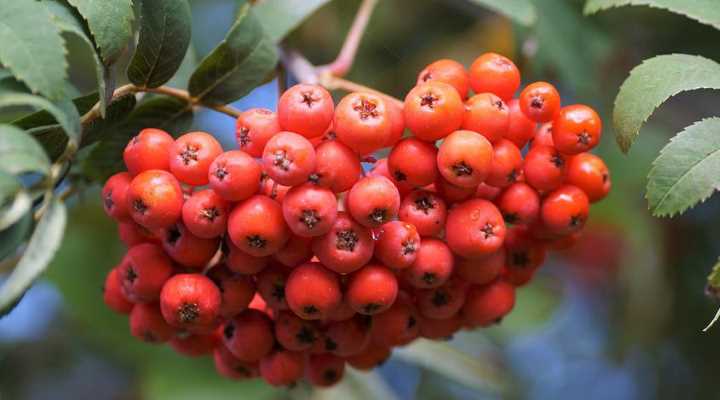
Rowan fruit is berry-like and grows in dense clusters. It is usually bright red or orange
Berries growing on the rowan tree are one of its most attractive features. The bright red or orange edible berry-like pomes measure 0.25” (6 mm) and grow in dense clusters. Eye-catching vibrant berries ripen in late summer or fall and persist on the tree until winter.
Although called a berry, rowan tree fruit is a type of pome or accessory fruit. The small round fruits grow densely in clusters, and their vivid colors stand out against the dark foliage. The red or orange berries also add color to a winter landscape after the tree’s leaves drop.
Rowan tree berries are edible. However, the small round pomes have a naturally bitter taste and are unpalatable eaten straight off the tree. Additionally, raw rowan berries are slightly poisonous and must be cooked to break down the acid. Typically, rowan berries are made into delicious jellies.
The bright colors of rowan tree berries attract birds and small mammals looking for food in the fall and winter.
Rowan Tree Leaves
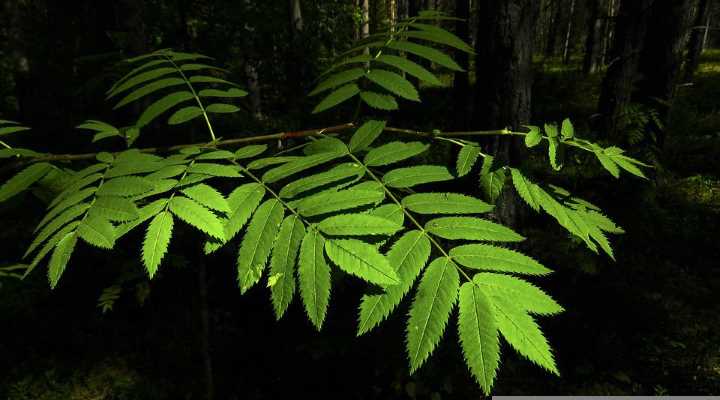
Rowan tree leaves
Leaves growing on the rowan tree are one of its easily identifiable traits. The pinnately compound leaves measure 6” to 10” (15 – 25 cm) long. Each leaf consists of lanceolate leaflets with serrated edges measuring 2” to 4” (5 – 10 cm) long. An identifying characteristic is alternate leaf growth.
Rowan tree leaves are deciduous. After the leaves emerge, they take on a dark gray to grayish-silver color in spring and in summer. In the fall, rowan tree foliage turns golden yellow, brightening a landscape. The green leaves then turn yellow, red, or burgundy add to the tree’s aesthetic visual appeal.
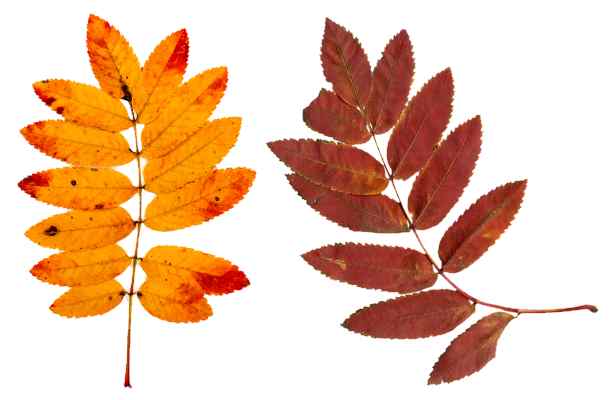
Rowan leaves in autumn
Rowan Tree Flowers

Rowan tree flowers are tiny white and grow in clusters
Flowers on the rowan tree bloom in late spring. The clusters of tiny white flowers grow in corymbs—flat-topped clusters. The small 4-petaled urn-shaped flowers form clusters measuring 3” to 6” (7.5 – 15 cm) across. The late-blooming spring flowers persist until summer.
Rowan Tree Bark
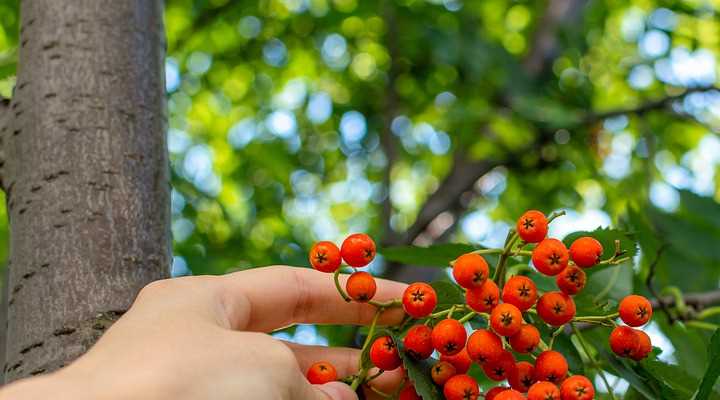
Rowan tree bark
The bark on the rowan tree trunk is generally smooth and gray. As the tree matures, the gray bark becomes scaly, with numerous lenticels (raised pores) creating irregular patterns on the trunk.
Rowan tree twigs are a reddish brown color with terminal buds that usually have a fuzzy appearance.

Rowan bud
Rowan Tree Growth Habit
A rowan tree is a slow-growing tree with an open, spreading crown. The deciduous tree performs best in full sun or partial shade. It thrives in fertile soils that are well-drained and continuously moist. Rowan trees are cold-hardy in USDA zones 2 through 6.
Rowan trees are ideal for planting in a garden landscape where they have visual appeal through most of the seasons. The white flowers decorate spring and summer landscapes, the dense foliage makes the rowan an ideal shade tree, and its vibrantly colored berries are attractive in fall and winter.
Types of Rowan Trees
The two main species of rowan tree are the American rowan tree (mountain ash) and the European rowan tree. There are several other species, but most share similar characteristics.
American Rowan Tree (Sorbus americana)
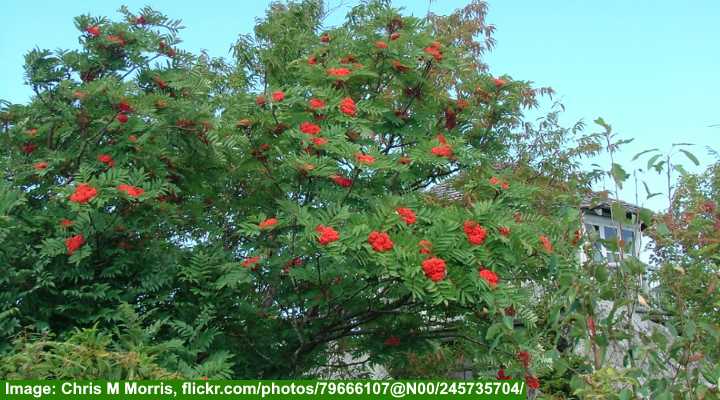
The American rowan tree (Sorbus americana) is also called the American mountain ash
The American rowan tree is an elegant small to medium tree native to northeastern America. The attractive ornamental tree grows 15 to 35 ft. (4.5 – 10 m) tall and wide. Its identifying features are dark green compound pinnate leaves, bright orange-red berries, and dense foliage forming a spreading crown.
Also called the American mountain ash, this rowan species thrives in USDA zones 2 through 6. The American rowan performs best in full sun for excellent blooming and fruit production. However, it will also tolerate some shade during the middle of the day.
The American rowan tree is relatively easy to identify in a landscape. The open rounded crown sits on top of a short trunk. Its bark is smooth, light gray with dark gray patches. As the tree ages, the trunk becomes scalier and develops cracks and splits.
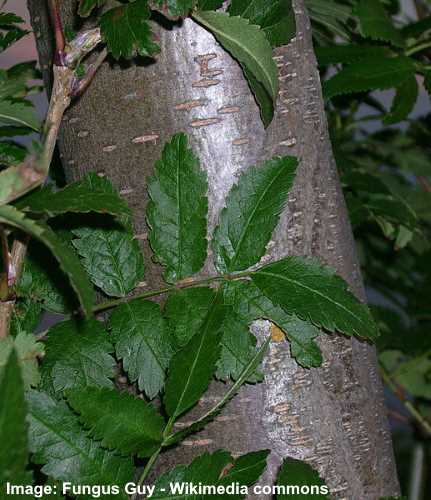
American rowan bark
The American rowan tree is ideal for a garden landscape, thanks to its four-season visual interest. First, leaves appear, then white flowers in late spring bloom throughout the summer. Then, in the fall, the American rowan tree develops eye-catching yellow foliage contrasting with bright red berries. Finally, in winter, the orangey-red berry clusters persist on bare branches.
In a sunny landscape, the American rowan tree is ideal as a shade tree, lawn tree, or decorative flowering tree. The rowan tree thrives in acidic, well-drained, loamy soil. Usually, rowan trees perform poorly in dense, clay soil.
American rowan tree berries: The berry-like pomes are small, brightly colored orange-red round fruits growing in clusters. The edible berries have an astringent taste. However, they persist on the tree after the leaves have fallen, adding to the tree’s winter appeal.
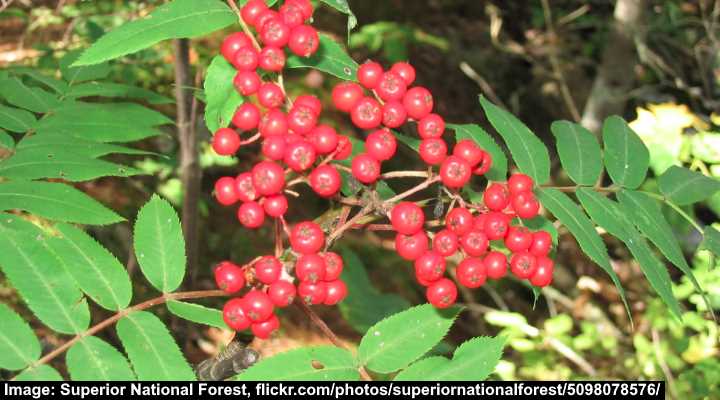
American rowan fruit and leaves
American rowan tree leaves: The pinnately compound leaves measure 6” to 10” (15 – 25 cm) long and have 9 to 17 leaflets on each petiole. The leaflets are wedge-shaped and measure 2” to 4” (5 – 10 cm) long. The green leaves turn bright yellow in the fall.

American rowan leaves and flowers
American rowan tree flowers: The showy flowers are flat-topped corymbs measuring 3” to 6” (7.5 – 15 cm) across. Each flowering cluster comprises small bell-shaped creamy-white flowers, each having four petals. The American rowan tree blooms in June and July.
USDA growing zones: 2 to 6
How to grow the American rowan tree
Plant an American rowan tree in a sunny location where it gets at least six hours of sunlight daily. The small decorative tree performs best growing in humus-rich, acidic soil with excellent drainage. Only water the ground when the top 2” or 3” (5 – 7.5 cm) is dry and mulch around the root area once a year.
You only need to prune the American rowan tree to remove dead or diseased branches. It’s best to prune the tree in late fall.
European Rowan Tree (Sorbus aucuparia)

European rowan tree (Sorbus aucuparia) is also called the European mountain ash
The European rowan tree is a small to medium deciduous multi-stemmed tree with an irregularly shaped, rounded crown. Its clusters of white flowers, showy dark-green leaves, and deep red berries give this ornamental tree plenty of appeal in a landscape. The European rowan grows 20 to 40 ft. (6 – 12 m) tall and 8 to 25 ft. (2.4 – 7.6 m) wide.
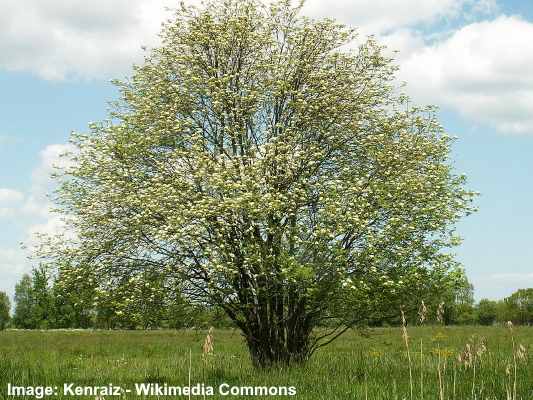
European rowan tree in bloom
Also called the European mountain ash, the European rowan tree performs best in USDA zones 3 through 7. However, the small decorative tree may struggle in the coldest zones unless planted in full sun. It also grows slowly, averaging less than 12” (30 cm) per year.
European rowan tree bark is dark to light gray that takes on a scaly appearance as it ages. You can identify the tree by its slightly rough-textured bark, flattened lenticels, and white speckles.
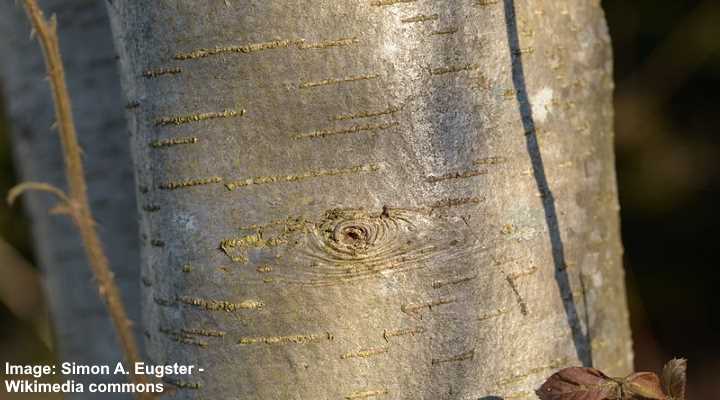
European rowan tree bark
Like the native American species, the European rowan species has landscaping value in four seasons.
Spring is characterized by its dark green fern-like leaves growing densely on spreading branches. These are enhanced by showy, flat-topped corymbs that persist through summer. In fall, the tree transforms into spectacular red, purple, and golden yellow hues as the foliage changes. Then dark red berries provide color in a barren winter landscape.
Growing in full sun, the European rowan tree is a popular landscape tree for sunny gardens. Its dense foliage and relatively short height make it an ideal flowering shade tree for small to medium-sized yards. You can also plant the hardy tree as a lawn or specimen tree.
European rowan tree berries: The berry-like pomes are dark red or burgundy, but sometimes orange, growing in dense clusters. The small summer fruits measure 0.33” (0.84 mm) across and ripen in late summer or early fall. These showy orange-red berries persist on the tree through winter and are an ideal food source for wildlife.
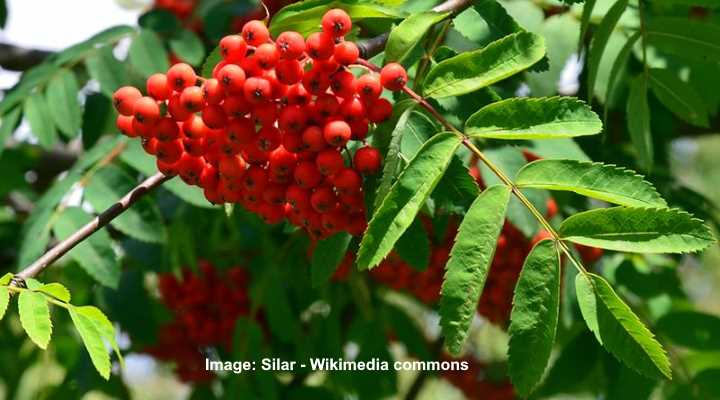
European rowan fruit and leaves
European rowan tree leaves: The leaves are pinnately compound, with 9 to 15 leaflets growing alternately on each petiole. Each lance-shaped, oblong serrated leaflet measures 2.5” (6 cm), and the leaves grow 5” to 9” (13 – 22 cm) long.
The deciduous leaves are green from spring until early fall before they turn color. Then, the showy leaves turn spectacular shades of golden yellow, red or purplish-red in the fall.
European rowan tree flowers: The flowers are tiny white urn-shaped blossoms that form dense, showy flattened clusters. Rowan trees bloom in late spring, and the white flowers persist for most of the summer.

European rowan flowers
USDA growing zones: 3 to 7
How to grow European rowan tree
The European rowan tree is easy to grow in a sunny landscape. Plant the European rowan tree in full sun or partial sun. It’s vital that the ground is well-drained and is kept continuously moist. This means mulching around the root area and watering whenever the top layer of soil dries out.
Other Types of Rowan Trees
California rowan tree (Sorbus californica): This rowan tree species is a shrub-like tree that produces small, round orange-red pomes, and compound leaves with serrated leaflets. The native rowan tree grows 13 ft. (4 m) tall and suitable for USDA zones 2 to 7.

California rowan tree leaves and fruit
Sorbus fruticosa: This species is a medium-sized deciduous shrub or small tree unique for its reddish twigs, fern-like green leaves that turn red in the fall, and eye-catching white berry-like pomes. The shrub-like tree grows up to 20 ft. (6 m) tall.
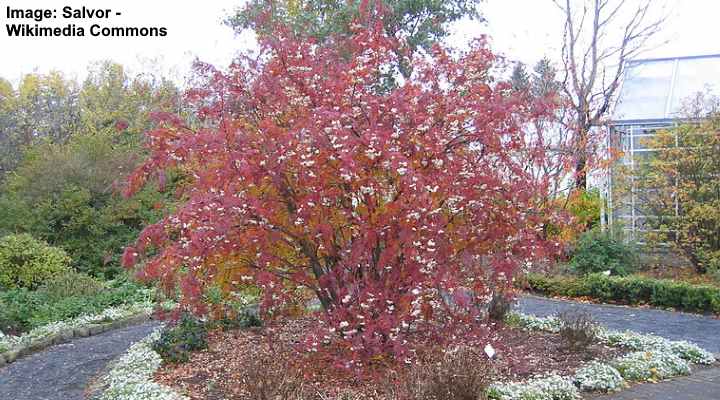
Sorbus fruticosa in autumn
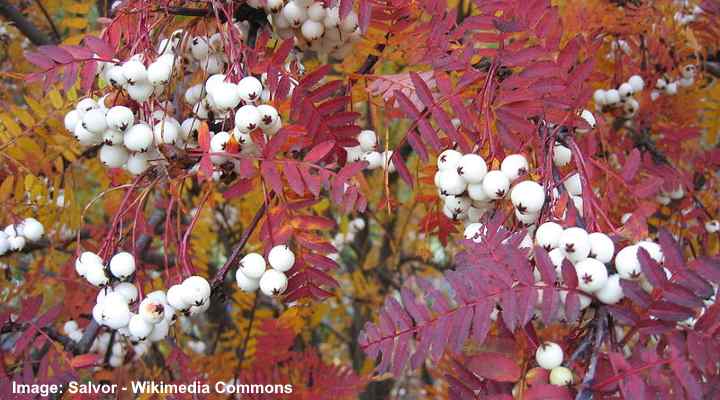
Sorbus fruticosa has white berry-like fruit
White-fruited rowan tree (Sorbus glabrescens): This rowan tree cultivar is easy to recognize for its abundant clusters of pinkish-white berries. The identifying features of this rowan tree are its glaucous blue-green foliage, white flowers with yellow stamens, and white fruits hanging on bare branches in the winter.
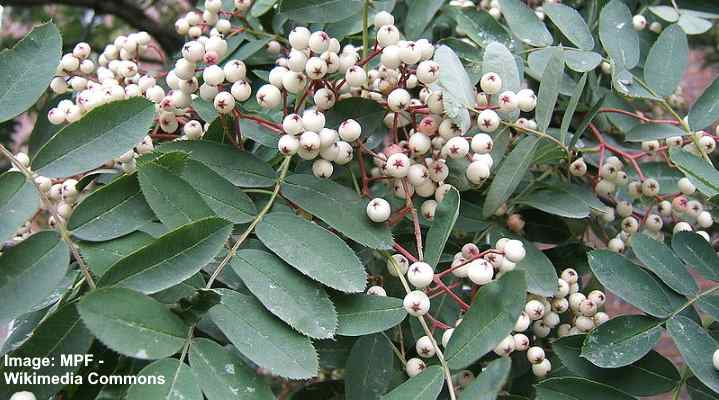
White-fruited rowan tree (Sorbus glabrescens)
Dwarf Chinese mountain ash (Sorbus reducta): This dwarf rowan shrub-like tree only grows 5 ft. (1.5 m) tall, making it perfect for containers or compact gardens. The pinnate leaves are dark green in the spring and summer before turning stunning shades of red in the fall. The plant’s white flowers are followed by red or pinkish-white berries that turn white by fall.

Dwarf Chinese mountain ash (Sorbus reducta)
Sargent’s rowan tree (Sorbus sargentiana): Native to China, this tree features the largest leaves of all the rowan tree species. The dark green lance-shaped leaves have prominent veining and serrated margins. In the fall, the attractive foliage turns a deep orange-pink or dark red to purple. Like most rowan trees, it has white flower clusters and orange or red berries.
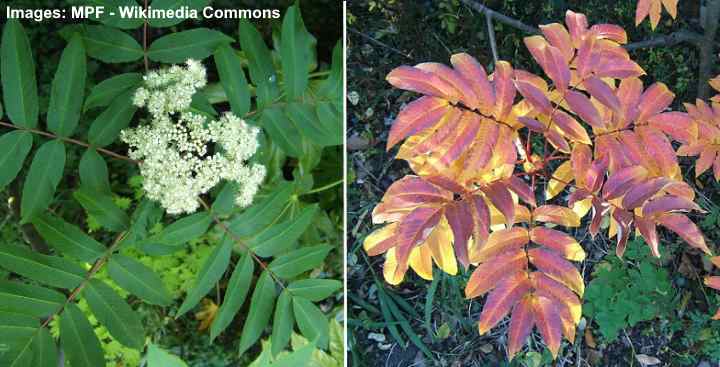
Sargent’s rowan tree (Sorbus sargentiana)
Related articles:
